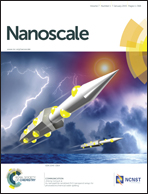Three-dimensional scanning near field optical microscopy (3D-SNOM) imaging of random arrays of copper nanoparticles: implications for plasmonic solar cell enhancement†
Abstract
In order to investigate the suitability of random arrays of nanoparticles for plasmonic enhancement in the visible-near infrared range, we introduced three-dimensional scanning near-field optical microscopy (3D-SNOM) imaging as a useful technique to probe the intensity of near-field radiation scattered by random systems of nanoparticles at heights up to several hundred nm from their surface. We demonstrated our technique using random arrays of copper nanoparticles (Cu-NPs) at different particle diameter and concentration. Bright regions in the 3D-SNOM images, corresponding to constructive interference of forward-scattered plasmonic waves, were obtained at heights Δz ≥ 220 nm from the surface for random arrays of Cu-NPs of ∼60–100 nm in diameter. These heights are too large to use Cu-NPs in contact of the active layer for light harvesting in thin organic solar cells, which are typically no thicker than 200 nm. Using a 200 nm transparent spacer between the system of Cu-NPs and the solar cell active layer, we demonstrate that forward-scattered light can be conveyed in 200 nm thin film solar cells. This architecture increases the solar cell photoconversion efficiency by a factor of 3. Our 3D-SNOM technique is general enough to be suitable for a large number of other applications in nanoplasmonics.


 Please wait while we load your content...
Please wait while we load your content...